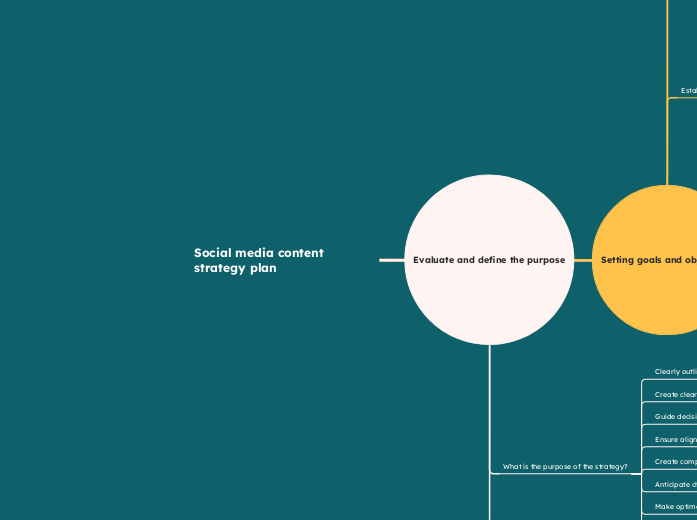Social media content strategy plan
Evaluate and define the purpose
What is the purpose of the strategy?
Clearly outline goals and objectives
Create clear direction and focus
Guide decision-making and prioritization
Ensure alignment with overall business objectives
Create competitive advantage and differentiation
Anticipate challenges and mitigate risk of failure
Make optimal use of resources
Create a roadmap for achieving desired results
Measure the effectiveness and success of campaigns
Why is it important?
pros
Creates a sustainable platform for success
Consistent and cohesive multi-platform brand image
Proactive targeting and reaching the desired audience
Time efficiency
cons
Time-consuming and requires continuous effort
Investment - tools, resources, management, paid adverts
Risk of negative feedback from the audience
Challenge of staying current with trends and algorithms
Setting goals and objectives
Identifying target audience
Market research to understand the demographics of who will benefit from your solution
Consider current size, growth potential and expendable income
Create marketing avatars to better understand the target audience's needs, preferences, expectations and desires
pain points
solutions
favourite platforms
preferred content
Be clear you understand the customer and the perception of value they have of your offer
Analyzing competitor's social media channels to gain insights into target audience
profile
content
engagement
posting frequency
Set results targets
Drive engagement and reach
Drive website traffic
Build brand awareness and loyalty
Improve customer service
Generate leads and conversions
Establish thought leadership and authority
Analyze and improve performance
Set output targets
Blog once a week
Create video content
Post once a day
Establishing key performance indicators (KPIs)
ROI (Return on Investment)
Likes
Conversions
Website Traffic
Reach
Followers
CTR (Click through rate)
Content distribution and promotion
Choosing appropriate social media platforms
Target audience analysis for social media platforms
Evaluating the strengths and weaknesses of different social media channels
Identifying the most effective social media platforms for content distribution (that you can create)
Research new entrants and alternative approaches
Choose a manageable amount of channels
Scheduling and optimizing content posting
Create a calendar to plan and schedule content posting
Daily
Weekly
Bi-weekly
Research relevant hashtags and optimal amount
captions
tags
visual elements
Decide which content can be repurposed or shared
Utilize social media scheduling tools to automate content posting and save time
Paid
Free
Use analytics to determine the best times to post content for maximum engagement
Engaging with the audience
Respond promptly
Be supportive
Lead debate
Ask questions
Find communities
Collaborating with influencers and partners
Co-creating content with influencers (or anyone!) to increase reach and engagement
Partnering with brands to cross-promote content and reach a wider audience
Sharing relevant content with endorsement
Signposting to trusted sources
Engaging with industry experts to enhance credibility and authority
Consider Paid advertising (if budget allows)
Pros
Increased visibility and reach to a larger audience
Targeted advertising options to reach specific demographics
Quick and immediate results in terms of increased traffic and engagement
Cons
Costly
especially for small businesses or limited budgets
Ad fatigue and potential for ad blindness by users
Difficulty in measuring the return on investment (ROI) of paid advertising
Content creation and curation
Researching relevant topics and trends
Creating valuable, relevant, engaging & shareable content
Share
Concepts
Ideas
Beliefs
Theories
Type
Stories
Quotes
Reviews
Information
Commentary
Polls
Q&A
Medium
Video
Live stream
Image
Blog excerpt
Graphic Design
Visme
Animation
Infographic
Piktochart
Podcast clip
Creating quality content
Use high quality images & video to grab attention
Use clear, concise and engaging copy
Adhere to recommended sizing and structure
Consider length of content to influence engagement metrics
Curating content from other sources
Share others content being mindful of copyright
Repost existing video with commentary
Link to 3rd party website
Measurement and analysis
Monitor social media metrics
Direct from platform
Scheduling management tool
Analyzing data and insights
Making adjustments and improvements
Feedback from comments
Study successful competitors
Keep updated
Trends
Algorithms
Features
Experiment
Test different content styles
Try posting at different times
Hashtags
groups
quantity
Reporting and evaluating the success of the strategy
Compare the strategy's performance against industry benchmarks to assess its success
Stay fluid and assess the strategy's impact, look for opportunities and implement improvements
